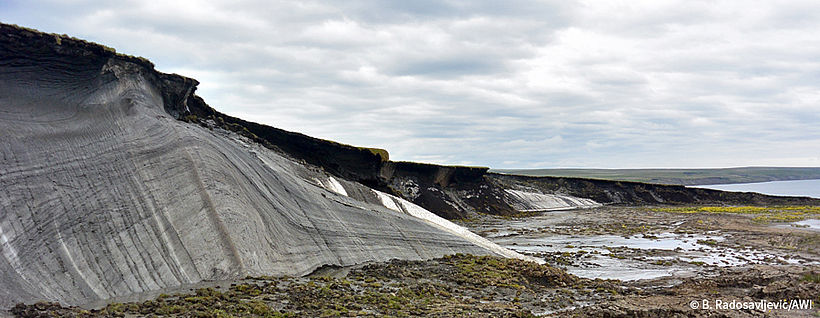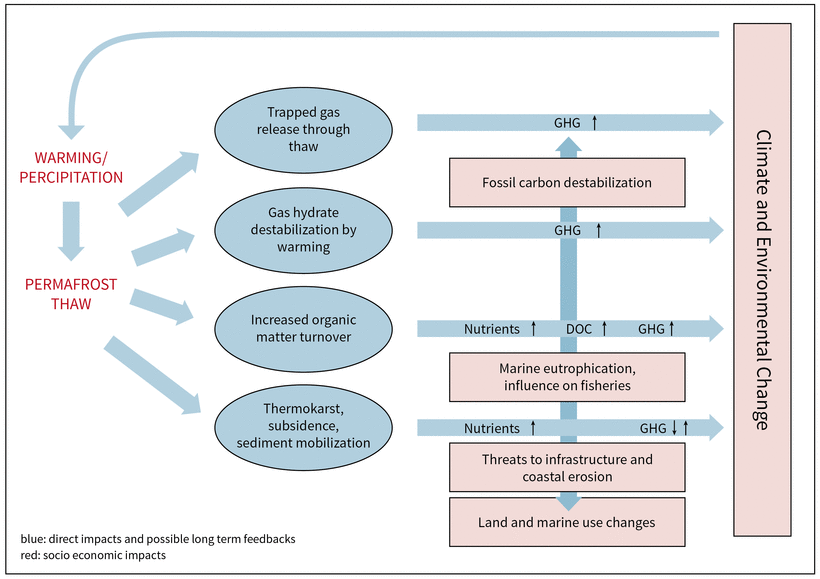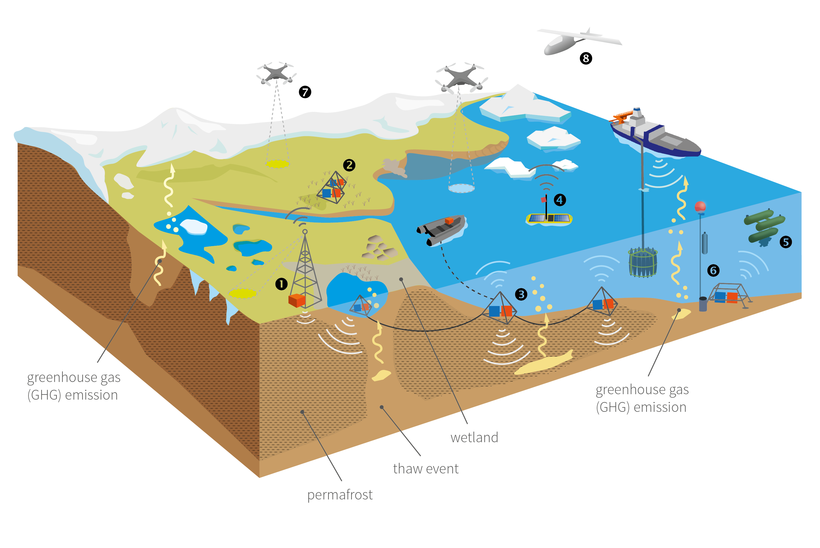
Abrupt Permafrost Thaw
Due to climate warming, Permafrost is thawing on a pan-arctic scale. This ongoing process is accompanied by abrupt and distinct thaw events (“thermokarst”) which are observed with increased frequency and intensity, for example, in North Western Canada or Siberia. This poses two main threats: destabilization of the ground and the built infrastructure, and the release of greenhouse gases from mobilized fossil carbon pools. While the first actively only affects communities on a rather local scale, the latter acts globally since it rapidly releases fossil permafrost carbon to the atmosphere. Such abrupt thaw events contribute to a yet unknown extent to further climate warming.
The event chain approach for investigating abrupt permafrost thaw aims at understanding and quantifying the contribution of dynamic thaw events to ground destabilization and to the greenhouse gas emissions in the Arctic. With interlinked observations of the land surface, lakes, coastal and offshore regions, three strands of event chains are the focus of MOSES campaigns:
- Changing water surfaces due to
intensified lake changes, sea level rise and coastal erosion lead to
accelerated permafrost warming and thaw. Especially coastal erosion threatens
Arctic communities.
- Thaw events create new pathways for gas migration and thus accelerate the decay and release of fossil organic matter.
- The temporal and spatial variability
of greenhouse gas fluxes is mapped and monitored to unravel the changing role of permafrost.
 Schematic diagram of event chains triggered by permafrost thaw. As permafrost acts as an impermeable layer, it seals and thus prevents gas exchange between deeper sediment layers and the atmosphere/water. Thaw events in summer and massive permafrost degradation enable trapped gas to be mobilized and released, destabilizing fossil carbon pools (mainly CH4 as potent GHG) and increasing climate warming. Similarly, the warming of terrestrial and marine sediments will destabilize gas hydrates and, in this case, mobilize a fossil carbon source of rather unknown size. The thaw of permafrost makes previously frozen organic matter available for decomposition, causing direct release of CO2 or CH4 and the release of nutrients. These nutrients might cause eutrophication along the coast and the open ocean with unknown consequences to ecosystems, finally affecting fish stock. On land, thawing permafrost causes subsidence and is thus a direct threat to infrastructure stability; along the coasts, ongoing erosion on a massive scale transports nutrients into the oceans, changing ecosystems and the way they function. The use of both land and coastal areas will irreversibly change in the near future.
Schematic diagram of event chains triggered by permafrost thaw. As permafrost acts as an impermeable layer, it seals and thus prevents gas exchange between deeper sediment layers and the atmosphere/water. Thaw events in summer and massive permafrost degradation enable trapped gas to be mobilized and released, destabilizing fossil carbon pools (mainly CH4 as potent GHG) and increasing climate warming. Similarly, the warming of terrestrial and marine sediments will destabilize gas hydrates and, in this case, mobilize a fossil carbon source of rather unknown size. The thaw of permafrost makes previously frozen organic matter available for decomposition, causing direct release of CO2 or CH4 and the release of nutrients. These nutrients might cause eutrophication along the coast and the open ocean with unknown consequences to ecosystems, finally affecting fish stock. On land, thawing permafrost causes subsidence and is thus a direct threat to infrastructure stability; along the coasts, ongoing erosion on a massive scale transports nutrients into the oceans, changing ecosystems and the way they function. The use of both land and coastal areas will irreversibly change in the near future.
Highly mobile and interoperable measuring systems are required to monitor the multiple and interconnected processes of the different environmental systems. Such a concerted observation campaign for abrupt permafrost thaw is illustrated in the block diagram.
 MOSES measurement infrastructure to quantify permafrost thaw events on terrestrial, aquatic and subsea systems. The different observation systems are fully mobile and extend existing measurement facilities. The MOSES observation systems include long-term quantification of GHG fluxes and their isotopic composition with stationary systems/towers (1) (land-atmosphere fluxes). Event-based quantification of permafrost thaw and subsidence events as well as GHG fluxes and their isotopic composition, both on land (2) and in water bodies (3), with mobile systems (landatmosphere fluxes; permafrost thaw and Subsidence; flow and sediment dynamics). Quantification of GHG fluxes in the deeper marine offshore system using GHG-flux measuring Wave Glider (4), bubble flux observing AUVs (5) (both autonomous vehicles) and lander systems (6) also monitoring environmental parameters as currents, O2 and CO2 concentrations (fixed point observatories). In addition, various tools for water and sediment sampling will be deployed from small boats and larger ships. Airborne quantification of permafrost thaw events and GHG fluxes using drones (7) and fixed wing UAV (8) equipped with eddy covariance (autonomous vehicles and land-atmosphere fluxes).
MOSES measurement infrastructure to quantify permafrost thaw events on terrestrial, aquatic and subsea systems. The different observation systems are fully mobile and extend existing measurement facilities. The MOSES observation systems include long-term quantification of GHG fluxes and their isotopic composition with stationary systems/towers (1) (land-atmosphere fluxes). Event-based quantification of permafrost thaw and subsidence events as well as GHG fluxes and their isotopic composition, both on land (2) and in water bodies (3), with mobile systems (landatmosphere fluxes; permafrost thaw and Subsidence; flow and sediment dynamics). Quantification of GHG fluxes in the deeper marine offshore system using GHG-flux measuring Wave Glider (4), bubble flux observing AUVs (5) (both autonomous vehicles) and lander systems (6) also monitoring environmental parameters as currents, O2 and CO2 concentrations (fixed point observatories). In addition, various tools for water and sediment sampling will be deployed from small boats and larger ships. Airborne quantification of permafrost thaw events and GHG fluxes using drones (7) and fixed wing UAV (8) equipped with eddy covariance (autonomous vehicles and land-atmosphere fluxes).
Permafrost campaigns were conducted in 2018 and 2021 in the region of the Mackenzie River Delta in Canada as part of the implementation period. From 2022 onwards, campaigns are carried out as part of the MOSES operating phase.
Coordinator
Prof. Julia Boike, AWI | julia.boike@awi.de

